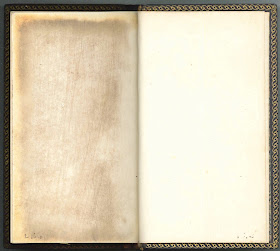What's with the stained blank page? If you could feel it, you would also ask why it feels so odd. It has a kind of waxy coating, feels a little like vellum, but not as supple, and it has streaks of old ink set into its scratched surface.
We often value our old books for the extensive marginalia left behind by generations of readers. The comments give us insights into how the text was received in other times and places. But not all readers wanted to fill their books with notations.
This copy of the Elsevier 1665 edition of Boccaccio's Decameron was highly portable, but the compact size left little room in the margins for notes. The solution was ingenious. At the front and back are two leaves very different from the rest of the paper in the book. These are erasable surfaces, where a reader could jot down notes as he or she read. The reader could then transcribe the notes into a commonplace book and, with a damp rag, rub away the comments. The book stays clean, the notes are captured, and there is space for further musings.
The staining shows at least one reader was actively using the erasable pages to record thoughts, what they were, we will never know.
Ask for Presses E52bo.

No comments:
Post a Comment